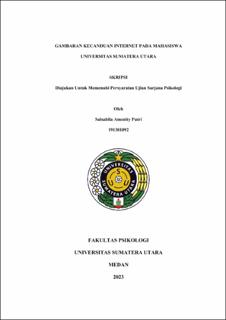| dc.description.abstract | Students who are addicted to the internet can experience negative impacts of internet addiction that can affect their academics and daily activities. This study aims to describe internet addiction along with the negative impacts experienced by students at the University of North Sumatra in each category of internet addiction. The scale used in this research is the Internet Addiction Test (IAT) and self-reports on the negative impact of internet addiction. There were 349 students who were sampled in this study. The research sample was determined using non-probability sampling with a purposive sampling technique. The results showed that 38% of students had mild internet addiction, 54% of students had moderate internet addiction, and 8% of students had severe internet addiction. The negative impact of internet addiction that has the highest frequency in the mild level of internet addiction is fear of missing out and health problems, which is 78. In the moderate level of internet addiction is nomophobia, which is 103. Then in severe internet addiction is phubbing and health problems, which is 16. | en_US |


